
Dying truths about quitting smoking methods
Since this 2011 article was written, a July 2013 Gallup Poll found that after 30 years (since 1984) and billions spent marketing Nicorette, that only 1 in 100 successful quitters credit nicotine gum for their success. As I suggest in a November 19, 2013 letter published in the British Medical Journal, with all approved products combined accounting for only 8% of successful cessation, "How much closer to consumer fraud can approved products get?"
Three decades of stop smoking product advertisements have left smokers convinced that quitting without the nicotine patch, gum, lozenge or Chantix is difficult to near impossible. Industry ads are designed to get smokers to fear their natural quitting instincts. So, which quit smoking method works best? Who should smokers trust, their instincts and gut, or industry ads?
Neal, age 53, successfully quit smoking cold turkey on January 10, 2011 and Helen, age 50, did the same four years ago. So, why would discussing quitting methods stir emotions in both? Interestingly, their outrage was present before being diagnosed with lung cancer, before being told they were dying.
Neal and Helen graduated from the school of hard-quitting-knocks. It's a race against destruction where delay in discovering truth allows arrival of daily toxins to threaten graduation. So, what key lessons did Neal and Helen learn?
They learned that while approved quitting products clobber placebo controls inside randomized clinical trials, that placebo isn't a real quitting method. They discovered that their government had kept hidden and secret the fact that approved quitting products are not effective when used in an over-the-counter manner, that they'd failed to prevail over cold turkey quitters in nearly every real-world quitting method survey ever conducted.
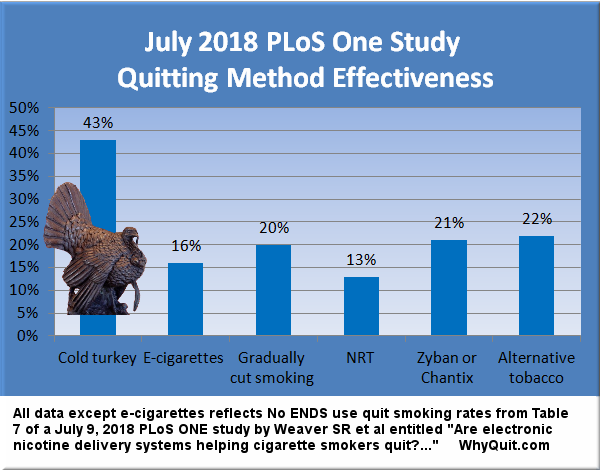
The most critical lesson learned is that so long as all nicotine remains on the outside that it's impossible to fail, but that just one puff and relapse is all but assured. They knew that lesson as the "Law of Addiction." Sadly, it's understanding both needed much sooner.
Helen, a former thirty year smoker, was diagnosed with lung cancer on September 3, 2011. "I went to the doctor because I had swollen hands, feet, ankles and knees," recalls Helen. "She sent me for all sorts of blood tests and x-rays. The last was a chest x-ray that showed a shadow on my left lung. The doctor suggested that, considering all my symptoms that it was probably lung cancer."
"I couldn't believe this was happening to me. I was so frightened. I spent all night and all of the next day crying. It was so hard telling everyone. I didn't want to believe it myself but every time I said I have a shadow on my lung and it's probably lung cancer, it became more real and more frightening."
But almost a year earlier, on November 14, 2010, Helen's thoughts were about her prior failed quitting attempts. "I want to ask why is it that we think that NRT works," she wrote. "Because pharmaceutical companies tell us it works? And who stands to gain from that?"
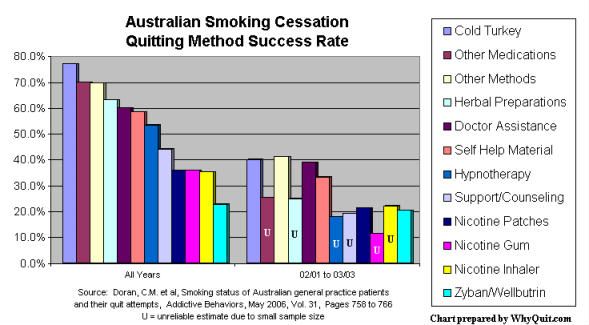
On February 9, 2011, before diagnosis, Neal wrote in his online quitting journal, "My past quit attempts left me addicted to other nicotine delivery devices. Leading up to this quit I had been addicted to nicotine lozenges for over a year, I used them and smoked cigarettes constantly. When I couldn't have a cigarette I would have a lozenge in my mouth. Occasionally I would smoke cigars. I tried the e-cigarettes, the inhalers, the gum, the patch, and I even tried oral tobacco to break up the routine. It was a real nicotine addict's heaven, but in reality it was hell."

Nicotine addiction is a brain wanting disorder, illness and disease that's every bit as real and permanent as alcoholism. To varying degrees and in different ways, approved quitting products satisfy brain dopamine pathway wanting previously satisfied by smoking more nicotine.
While these products nearly always prevail over frustrated placebo group study participants who joined wanting chemical satisfaction too, cold turkey quitters do not seek or use dopamine pathway stimulation substitutes. They don't pay money to lengthen recovery.
Helen believed and followed government quitting method recommendations too. "I used NRT twice, the first time was maybe about fifteen years ago. My friends and family were all on my case to quit. I used the patches for the full three months. Then, when it was time to stop using the patches, I started smoking again."
"The second time I used NRT was when my sister was diagnosed with breast cancer. She really got on my case. She was constantly reminding me, 'Helen, smoking causes cancer!' This time I wasn't able to stop smoking even while wearing the patch. Each week the quitting nurse I was working with would tell me to not smoke while wearing the patch, but I just couldn't stop. In the end we just gave up on each other."
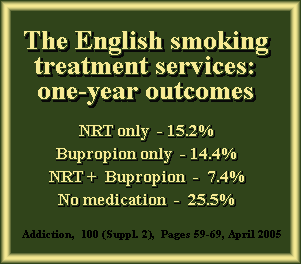 As Helen discovered with her first patch attempt, eventually quitting product use ends. Just like cold turkey quitters, product users must eventually readjust to natural dopamine pathway stimulation, unless of course, as with Neal, their chemical dependency becomes dependent upon the product.
As Helen discovered with her first patch attempt, eventually quitting product use ends. Just like cold turkey quitters, product users must eventually readjust to natural dopamine pathway stimulation, unless of course, as with Neal, their chemical dependency becomes dependent upon the product.
On April 9, 2011, Neal wrote and shared an article documenting his recovery. He entitled it "The Real Me vs. The Junky." In it he wrote, "The Real Me still wanted so badly to surface and be free from the deep, dark, jungle. I tried and tried and even enlisted the help of gums, lozenges, patches, inhalers, e-cigs, and dip. I found myself in worse shape then when I started. Not only was I still buried in the jungle, but now the lozenges were growing vines around my legs, and I could barely move."
Health officials have known since 2003 that, as witnessed with President Obama who was dependent upon nicotine gum for years, up to 7% of nicotine gum quitters become hooked on the cure. Officials have known since 2003 that roughly 93% of over-the-counter NRT users relapse to smoking within six months. But try to find any government quit smoking advice page that warns smokers of these facts.
"I originally named my first post journal "4 Decades Of Lies" because I have been smoking for over 40 years," wrote Neal on February 9, 2011. "The lies I was talking about was aimed at the tobacco and pharmaceutical companies, and the government for letting them do all that lying to us."
"When the doctors, nurses and media kept telling me that the patch doubles my chance of quitting I believed them," says Helen. "These guys are the professionals so they must be right. I'm the dropout so it must be all my fault that I can't stop smoking. So instead of jumping up and down and complaining that their product is faulty, I went away resigned to having to smoke for the rest of my life."
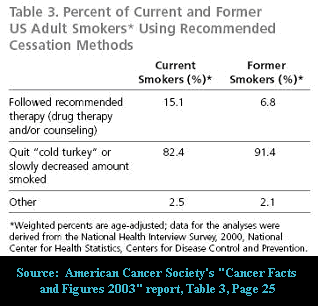 Why would government health officials suppress truth? Is it because they have three decades of credibility invested in placebo-controlled trials which they now know were not blind as claimed?
Why would government health officials suppress truth? Is it because they have three decades of credibility invested in placebo-controlled trials which they now know were not blind as claimed?
Imagine products that excel in clinical trials undermining successful cessation and costing lives in real-world use. Like an ostrich with its head in the sand, government health officials avoid, hide or ignore population level quitting data showing that use of approved quitting products is less effective than quitting without them.
A victim of three decades of "double your chances" lies, it's too late to save Neal. In fact, Neal died just 37 days after being diagnosed with lung cancer. His final journal post on June 16 described how during a routine doctor's visit he mentioned a swollen lymph node on his neck and ended ten days later being diagnosed with inoperable lung cancer.
"Needless to say, there were a lot of emotions and preparations for me to deal with," Neal wrote. "I wanted to continue to post my experiences in the hopes of helping people on here. We have to always be vigilant and realize the deadliness of this addiction we are fighting. I don't want any of you to experience the feeling I now get when my 9 year old daughter looks to me with all the love in her eyes."
Neal passed away on July 10, just 25 days after the above journal entry. What quitting advice would he have given? Neal would have wanted smokers to know that knowledge is power, that we can become far more dependency recovery savvy than our addiction is strong, and that it needs doing while still time.
On November 1, 2011, Helen wrote, "... I spent over a week in the hospital, so we aren't going to do any more chemo. It isn't such good news, I asked the doc how long I could live and he said one to three months."
Helen is growing weaker by the day. According to her sister Maureen who wrote on November 18, "The cancer has grown too big and it made the lung collapse. I took her to hospital in an ambulance yesterday. She will remain in there until we can get her stabilized." Helen's in need of a miracle, in need of prayers. And what quitting method would she recommend?
As she posted on WhyQuit's Facebook page on September 3, 2011, "If there is anyone out there thinking of quitting, do it now! Don't wait until it's too late to avoid all this pain and heartache like I did. Everything you need to quit is at WhyQuit.com: read the free quit smoking books, watch the videos, and use the support at Turkeyville. Throw that pack away and just take it one day at a time!"
On Friday, November 11, the U.S. Centers for Disease Control (CDC) released a study that verges on fraud. It's entitled "Quitting Smoking Among Adults --- United States, 2001 - 2010." This CDC report cites population level survey findings while asserting that "cessation medications are effective cessation treatments," that "... medication should be offered to patients willing to make a quit attempt," and that "use of effective medications ... nearly double to triple rates of successful cessation."
A fair reading of the report and above quoted language suggests that the U.S. government has seen long-term (greater than 6 months) population level data indicating that mediations are 2 to 3 times as effective as unassisted abrupt nicotine cessation (cold turkey) quitting. Sadly, nothing could be further from the truth.
In fact, the only population level stop smoking method analysis by the U.S. Department of Health and Human Services (USDHHS) is a 2006 National Cancer Institute study by Anne M. Hartman entitled "What Does U.S. National Population Survey Data Reveal About Effectiveness of Nicotine Replacement Therapy on Smoking Cessation?." As seen on PDF page's 35, 36 and 37 of the NCI study, contrary to the CDC's assertion that "mediations are 2 to 3 times as effective," Hartman found that "no medication" quitters actually had higher success rates than those using nicotine replacement therapy or Zyban at 9 months.
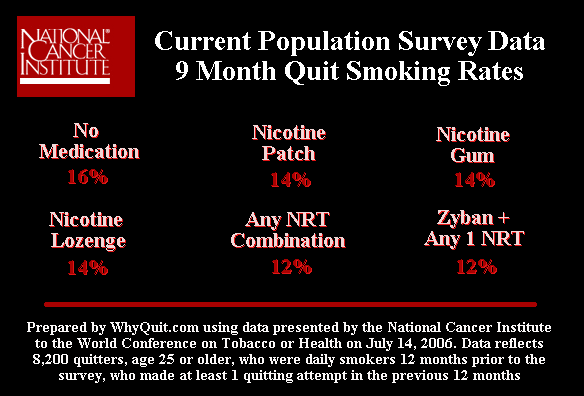
What's even worse is that the NCI study's "no medication" category is a composite of a number of quitting methods, some effective others not.
For example, a 2011 population level UK Smoking Toolkit Study by Professor Robert West (STS23) found that unassisted abrupt cessation (cold turkey) was nearly twice as effective as unassisted gradual withdrawal (odds ratio 1.89 - see Table at the top of page 9). Also note in the same Table that even after West combines effective abrupt cessation with ineffective gradual withdrawal, and uses the result as a reference called "Unaided" for comparing success to approved quitting products, that NRT was still found no more effective than this watered-down reference.
The obvious question for both Professor Robert West and the NCI's Anne Hartman is, would abrupt cessation have totally trounced medication if you had compared it to abrupt cessation only? Cheong's 2006 finding that "smokers who used the cold-turkey method to quit were almost twice as likely to abstain for a month or more in their attempt" than "gradual reduction" or "cut down" approaches suggests that it would.
Imagine medication saving lives inside clinical trials while costing lives in real-world use. Imagine government health officials watching the pharmaceutical industry's medicinization of smoking cessation bring decline in adult smoking rates to near standstill and ignoring it. Why? We don't know.
What we do know is that the NCI's Hartman study was never published, that the study itself is no longer available on any government website, that the new CDC report Friday failed to reference it, and that the reported quitting rate for "no medication" quitting would clearly have been significantly higher if the comparison were instead to unassisted abrupt cessation.
Sleep on this if thinking about quitting smoking. Nearly all population level quitting method surveys indicate that reliance upon medication alone is less effective than quitting without it. Keep your money in your pocket.
As for quitting without it, nicotine's half-life in a smoker's bloodstream is two hours and withdrawal peaks in intensity within 72 hours, and then begins to gradually decline. So long as zero nicotine enters the bloodstream your odds of success are 100 percent.

But the opposite is also true. Lapse nearly always equals relapse. Just one puff and within seconds up to half of the brain's dopamine pathway receptors will become occupied by nicotine. While most walk away from cheating thinking that they've gotten away with it, receptor saturation soon wears off and they find their brain wanting and begging for more.
As Neal and Helen would remind us, one is too many and a thousand never enough. There was always only one guiding principle determining the outcome for all ... no nicotine today. Each puff containing up to 81 cancer causing chemicals, I'm sure it would be Neal and Helen's prayer that you end your self-destruction while still time. Yes you can!

